Aside from World Cup rugby and Velib, the self-service bike-sharing program that at the moment seems to obsess le tout Paris, the most amusing cultural diversion here is the Giuseppe Arcimboldo exhibition at the Musee du Luxembourg.
Around the city, kiosks advertise fashion magazines offering advice to young women on how to flirt at Velib parking stations (with hair aptly wind-swept, feign difficulty with the automated pay system whenever a desirable man appears), and they also display colorful posters of puffy-cheeked faces made out of corn, pickles, garlic and cherries to promote Arcimboldo, the 16th-century Italian gimmick painter.
I had my doubts. But it turns out that the show's a charmer, not too shallow, admirably concise, almost chic. The glad mobs, forming polite, cheerful scrums before these stately paintings of people with vegetable faces and fish eyes seem to recognize in Arcimboldo something of the French impulse to bring order to everything.
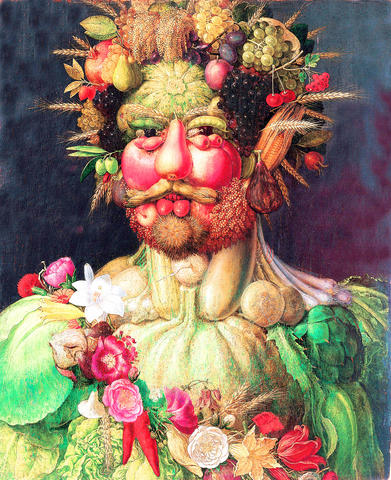
PHOTO: NY TIMES NEWS SERVICE
There is a temptation to find in the show's popularity a metaphor for the general mood here. France's hyperactive president, Nicolas Sarkozy, has embarked on a campaign of economic transition and tough love. He is pushing a new French globalism in lieu of the comfortable old welfare system that has guaranteed early retirement and many other benefits, along with high unemployment, especially among disenfranchised immigrants, to whom he has done conspicuously little to endear himself.
Arcimboldo's subject was the instability of life, its changeability in a widening world. His purpose was to inspire a fresh but not always entirely comforting sense of possibility and wonderment. Mercantile conquests by 16th-century European powers, France included, uncovered new continents, from which an ear of corn, exotic and rare, could serve not just as a visual pun for a human ear but also as a political symbol of faraway places, economies, peoples - of nature itself - brought to heel.
That said, I would hazard that the general horde of visitors, a good percentage of whom seem to be strapped into strollers and under 1m tall, don't dwell on metaphorical meanings. They wait in a long line that every day snakes out the front door of the museum into the Luxembourg Gardens, where parents dragoon reluctant children from the ancient carousel and pony rides out of the autumn sunshine toward the show, girded by the assuring sight of happy families exiting it.
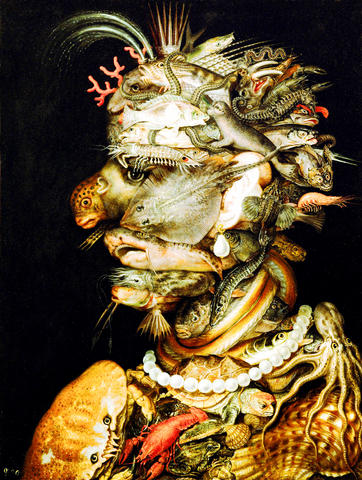
PHOTO: NY TIMES NEWS SERVICE
Mr. Fruit Face, as a friend of mine disdainfully calls him, has always been a guaranteed hit with the Transformers-age crowd. But his art is more serious and self-important than that. You can imagine him to have been the sort of initially jocular, learned dinner party companion whose arrogance makes itself known by the salad course. That he inspired thousands of appalling 20th-century Surrealists, apparently shocked at the genius of conceiving a gherkin to replace a nose, or a rose a cheek, isn't his fault.
Born in Milan in 1536, the son of a local artist, he started out painting conventional, darkling portraits. They're brittle but deft. He paid obeisance to Leonardo da Vinci via intermediaries like Bernardino Luini, who is said to have been a family friend. Commissions for stained glass and tapestries, permitting minor flights of peculiar fancy, eventually landed him in the employ of Maximilian II, in Vienna, then of Maximilian's cultivated son, Rudolf II.
There, he finally cooked up his famous faces. They satisfied a taste for exoticism. This was the era of high humanist curiosity. Newly rediscovered ancient texts like Pliny's Natural History circulated among scholars and artists; in the show, Archimbold's watercolors of animals and fish, exacting models he adapted for parts of faces, show him to be firmly grounded in science and real observation. Global exploration and advances in fields like optics and engineering stirred Rudolf, like other enlightened patrons, to wish to possess whatever was the rarest, the finest, the strangest, the most inexplicable art and artifacts. From such cabinets of curiosities - attempts to catalog and rationalize the irrational - evolved, one day, the modern museum. This was Arcimboldo's milieu and motivation.
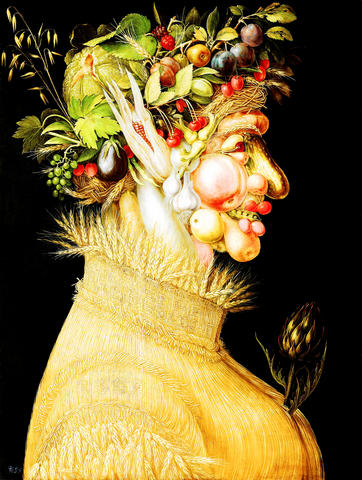
PHOTO: NY TIMES NEWS SERVICE
Usefully, the show includes more than a few works by sculptors and decorators who also catered to a fixation on the marvelous. Coconuts, conch shells, ostrich eggs and coral, gathered from the distant corners of the earth, become goblets, bowls and hilts for swords, three-dimensional versions of his painted faces. They're about art's roots in mysticism and magic. Painting itself is a sleight-of-hand trick, after all: colored dirt becomes an illusion.
Along which lines Arcimboldo clearly picked up pointers from Bosch and no doubt from Persian miniaturists. A gorgeous show of classic Iranian art happens to have just opened at the Louvre, and it includes several astonishing paintings from Arcimboldo's time: fantastical landscapes populated by wild creatures. Stare at the mountain scenes, and faces can begin to suggest themselves in the salt-taffy rock formations and trees.
All artists have their niches, and this commonplace slip of the mind became for Arcimboldo a virtual cottage industry. A bust of a bearded librarian, with a tin-man face made of books, and bookmarks for fingers, is a clever feat of virtuosity, like the reversible pictures he painted: right side up, they're still lifes; upside down, portraits.
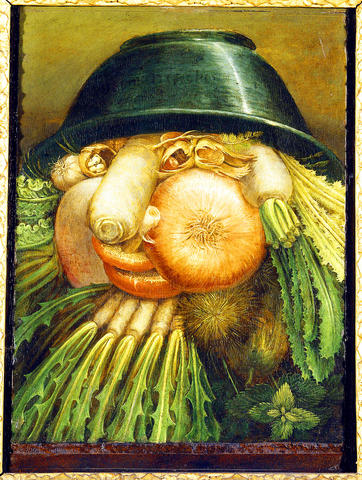
PHOTO: NY TIMES NEWS SERVICE
More interestingly, he also painted a three-quarter view of an old man, who, grossly desiccated, is memorably perverse by being somehow still dignified, almost courtly, in his dotage with branch stumps for stubble. Or there is the portrait of a German jurist, the humanist Johann Ulrich Zasius, with a plucked chicken for a head, a fish's mouth and a fish-tail chin. It's scary in ways that can almost remind you of Velazquez's portrait of Pope Innocent X, troubling the mind like a half-remembered nightmare.
So too are a quartet of stiff, plain-spoken little portraits of the family of Pedro Gonzalez. Their distinction was to grow hair all over their faces like the Wolf Man, an accident of nature akin to the Virgin Mary's portrait appearing in a grilled-cheese sandwich.
The universe concocts such marvels, which man emulates through art and industry in hopes to best it. That was Arcimboldo's bottom-line goal. His ambition, so frank and intellectual, gives to his prankish, often grotesque work its stylish hauteur.
Come to think of it, no wonder the French love him.

April 14 to April 20 In March 1947, Sising Katadrepan urged the government to drop the “high mountain people” (高山族) designation for Indigenous Taiwanese and refer to them as “Taiwan people” (台灣族). He considered the term derogatory, arguing that it made them sound like animals. The Taiwan Provincial Government agreed to stop using the term, stating that Indigenous Taiwanese suffered all sorts of discrimination and oppression under the Japanese and were forced to live in the mountains as outsiders to society. Now, under the new regime, they would be seen as equals, thus they should be henceforth

Last week, the the National Immigration Agency (NIA) told the legislature that more than 10,000 naturalized Taiwanese citizens from the People’s Republic of China (PRC) risked having their citizenship revoked if they failed to provide proof that they had renounced their Chinese household registration within the next three months. Renunciation is required under the Act Governing Relations Between the People of the Taiwan Area and the Mainland Area (臺灣地區與大陸地區人民關係條例), as amended in 2004, though it was only a legal requirement after 2000. Prior to that, it had been only an administrative requirement since the Nationality Act (國籍法) was established in

Three big changes have transformed the landscape of Taiwan’s local patronage factions: Increasing Democratic Progressive Party (DPP) involvement, rising new factions and the Chinese Nationalist Party’s (KMT) significantly weakened control. GREEN FACTIONS It is said that “south of the Zhuoshui River (濁水溪), there is no blue-green divide,” meaning that from Yunlin County south there is no difference between KMT and DPP politicians. This is not always true, but there is more than a grain of truth to it. Traditionally, DPP factions are viewed as national entities, with their primary function to secure plum positions in the party and government. This is not unusual
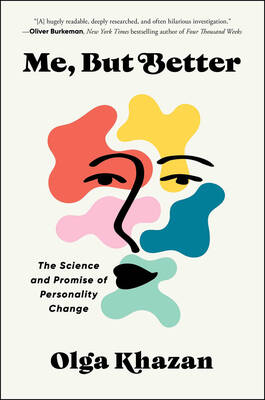
The other day, a friend decided to playfully name our individual roles within the group: planner, emotional support, and so on. I was the fault-finder — or, as she put it, “the grumpy teenager” — who points out problems, but doesn’t suggest alternatives. She was only kidding around, but she struck at an insecurity I have: that I’m unacceptably, intolerably negative. My first instinct is to stress-test ideas for potential flaws. This critical tendency serves me well professionally, and feels true to who I am. If I don’t enjoy a film, for example, I don’t swallow my opinion. But I sometimes worry